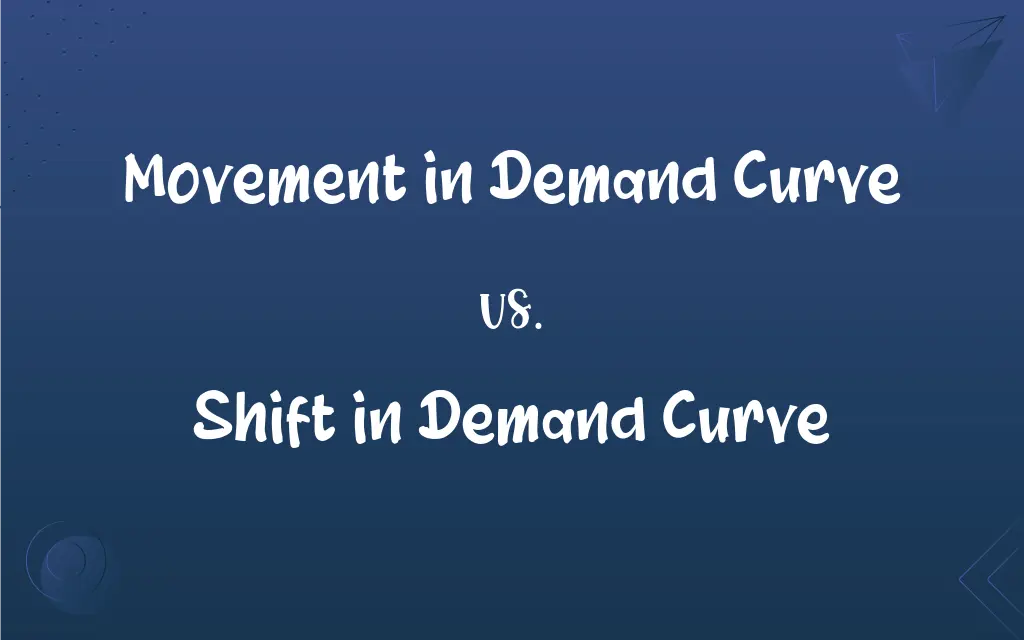Movement in Demand Curve vs. Shift in Demand Curve: What's the Difference?
Edited by Aimie Carlson || By Janet White || Published on February 25, 2024
A movement in the demand curve indicates a change in quantity demanded due to price changes, while a shift in the demand curve signifies a change in demand due to factors other than price.

Key Differences
Movement in the demand curve occurs along the curve when the price of the good changes, causing a change in the quantity demanded. A shift in the demand curve, however, happens when factors other than price, like consumer preferences or income, change, leading to a new demand level at every price.
A movement in the demand curve is typically either upward or downward, corresponding to a decrease or increase in quantity demanded due to price changes. In contrast, a shift in the demand curve is either to the right, indicating an increase in demand, or to the left, indicating a decrease in demand, for reasons unrelated to price.
When analyzing market dynamics, a movement in the demand curve helps understand the sensitivity of consumers to price changes. On the other hand, a shift in the demand curve provides insights into how external factors, like changes in consumer tastes or income levels, impact the overall demand for a product.
Economists use movement in the demand curve to illustrate the concept of price elasticity of demand. The shift in the demand curve, however, is used to demonstrate how non-price factors, such as advertising, consumer trends, or changes in population, alter the market's demand for a product.
The distinction between movement in and shift of the demand curve is crucial for businesses and policymakers. Understanding movements in the demand curve helps in pricing strategies, while shifts in the demand curve indicate broader market changes that might require adjustments in product offerings or marketing strategies.
ADVERTISEMENT
Comparison Chart
Cause
Caused by changes in the price of the product
Caused by factors other than the product's price
Direction of Change
Movement along the curve (upward or downward)
Entire curve shifts (rightward or leftward)
Indicates
Change in quantity demanded due to price change
Change in overall demand due to external factors
Impact on Price Elasticity
Demonstrates price elasticity of demand
Not directly related to price elasticity
Examples of Influencing Factors
Price discounts or increases
Changes in consumer income, preferences, or market conditions
ADVERTISEMENT
Movement in Demand Curve and Shift in Demand Curve Definitions
Movement in Demand Curve
Shows price-related changes in purchasing behavior.
During a sale, the demand curve for clothing moves downward as more items are bought at lower prices.
Shift in Demand Curve
Shows impact of external factors on consumer demand.
Effective advertising shifts the demand curve for a new beverage to the right, as more consumers are attracted to it.
Movement in Demand Curve
Represents the consumer response to price variations.
Lower airfare prices lead to a downward movement in the demand curve as more passengers book flights.
Shift in Demand Curve
Shift occurs when demand changes due to non-price factors.
A surge in health consciousness shifts the demand curve for organic food to the right, indicating increased demand.
Movement in Demand Curve
Indicates quantity demanded changes at different prices.
A price increase for smartphones causes an upward movement on their demand curve, reflecting reduced quantity demanded.
Shift in Demand Curve
Represents changes in demand irrespective of price.
Advancements in technology shift the demand curve for old-model smartphones to the left, as they become less desirable.
Movement in Demand Curve
Movement along the demand curve due to price changes.
If the price of coffee decreases, there's a downward movement along the demand curve as more coffee is demanded.
Shift in Demand Curve
Indicates a new demand level for a product at all prices.
An increase in consumer income shifts the demand curve for luxury cars to the right, reflecting higher demand.
Movement in Demand Curve
Visualizes changes in quantity demanded on a graph.
In response to increased gas prices, there's an upward movement on the gas demand curve, indicating less is bought.
Shift in Demand Curve
Reflects broader market or economic changes.
A demographic shift towards a younger population can shift the demand curve for tech gadgets to the right.
FAQs
How is movement in the demand curve depicted?
It's depicted as a slide along the existing curve, either upward or downward.
What causes a movement in the demand curve?
Movement is caused by changes in the price of the product itself.
Can price change cause a shift in the demand curve?
No, price changes result in movement, not a shift in the demand curve.
What leads to a shift in the demand curve?
Shifts are due to external factors like consumer tastes, income, or market conditions.
Does consumer income affect movement or shift in the demand curve?
It affects the shift in the curve, changing overall demand levels.
Can technological advancement cause a shift in the demand curve?
Yes, it can shift the curve for products affected by the advancement.
Can a movement in the demand curve be temporary?
Yes, especially if price changes are temporary, like sales.
What does a shift in the demand curve look like?
The entire curve moves to the right (increase in demand) or left (decrease).
How do seasonal changes impact the demand curve?
They can shift the curve if they alter overall demand patterns.
Does population growth cause movement or shift in the demand curve?
It causes a shift as it changes the overall market size and demand.
Is the movement in the demand curve always a response to price?
Yes, it's always a response to a change in the price of the product.
Can a shift in the demand curve be a long-term change?
Yes, shifts often represent long-term changes in market conditions.
Do movement and shift in the demand curve affect price elasticity?
Movement indicates elasticity, but shifts don't directly relate to elasticity.
Is advertising a factor in movement or shift of the demand curve?
It's a factor in shifting the curve, as it's an external influence.
What's an example of a shift in the demand curve due to social trends?
Increased environmental awareness shifting the curve for eco-friendly products to the right.
How do changes in competitors' prices affect the demand curve?
They can shift the demand curve for a product if they change overall market dynamics.
Can government policy cause a shift in the demand curve?
Yes, policies that affect consumer behavior can shift the demand curve.
How does consumer confidence affect the demand curve?
High confidence can shift the demand curve to the right, and low confidence can shift it to the left.
Can a movement in the demand curve reverse direction?
Yes, if the price changes again, the movement can reverse along the curve.
Does a movement in the demand curve imply a change in demand?
It implies a change in the quantity demanded, not overall demand.
About Author
Written by
Janet WhiteJanet White has been an esteemed writer and blogger for Difference Wiki. Holding a Master's degree in Science and Medical Journalism from the prestigious Boston University, she has consistently demonstrated her expertise and passion for her field. When she's not immersed in her work, Janet relishes her time exercising, delving into a good book, and cherishing moments with friends and family.
Edited by
Aimie CarlsonAimie Carlson, holding a master's degree in English literature, is a fervent English language enthusiast. She lends her writing talents to Difference Wiki, a prominent website that specializes in comparisons, offering readers insightful analyses that both captivate and inform.
































































